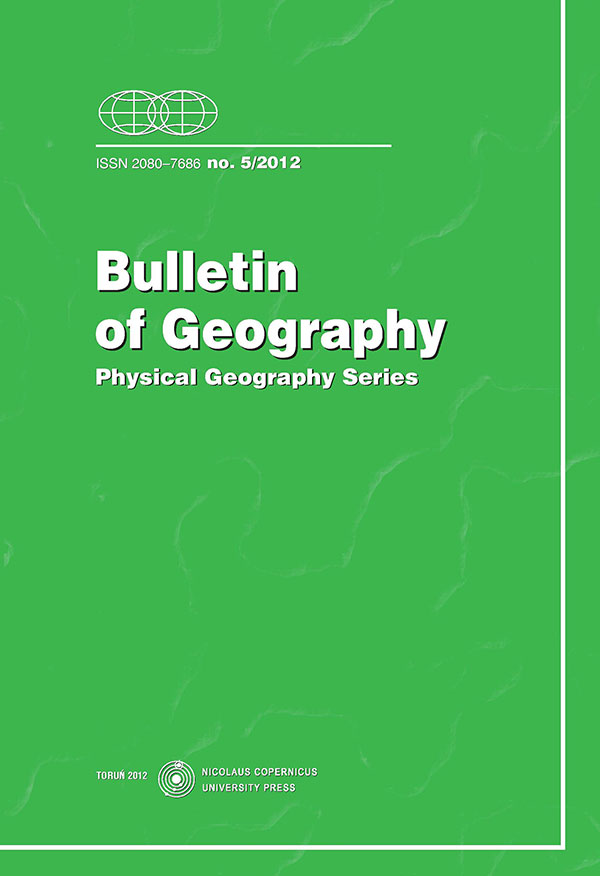Permafrost. The Contemporary Meaning of the Term and its Consequences
DOI:
https://doi.org/10.2478/v10250-012-0002-9Keywords
permafrost, definition, processes, extend, origin and ageAbstract
Nowadays the term ‘permafrost’ means the thermal state of the ground, for which the temperature limit value is 0°C remaining for at least two years. It is the effect of the climate where the average annual temperature of the air is -1°C or lower. As a result of air temperature, it does not need to contain ice, so it can no longer be called underground glaciation, and the only processes which are subject to permafrost are aggradation and degradation. Also the occurrence of permafrost in the geographical environment is conditioned neither by the presence of water nor its phase change - freezing, as the cryotic state is its synonym. Although it is known that the majority of permafrost dates back to the Pleistocene, still the determination of its age is difficult because it consists in determining ‘the age of the temperature’, as it were. The maximum thickness of permafrost occurs in the Antarctic, and it is estimated to reach 2600 m. Permafrost covers more than 25% of the Earth surface together with ice-sheets and ice-caps.References
ANANAJEVA-MALKOVA G.V., MELNIKOV E. S. and PONOMAREVA O. E., 2003, Relict permafrost in the central part of Western Siberia, [in: ] Philips M., Springman A., Arenson L.U. (eds.), Permafrost ICOP. Zuerich, 5-8.
BALCH E. S., 1900, Glacieres of Freezing Caverns, Philadelphia, Allen, Lane and Scott.
BLACK R. F., 1954, Permafrost: a review. Geological Society of America Bulletin, 65(9), 839-856.
BLACK, R. F., 1976, Features indicative of permafrost, Annual Reviews, Earth Planet. Sci., 4, 75-94.
BROWN, R. J. E. and KUPSCH, W. O., 1974, Permafrost terminology, National Research Council Canada, Associate Committee on Geotechnical Research, Ottawa, Technical Memorandum No. 111th.
DANILOV I. D., 1990, Podzemnyje l’dy, Moskva, Nerda.
DOBINSKI, W., 2006, Ice and environment: A terminological discussion, Earth Sci. Rev., 79, 229-240.
DOBIŃSKI W., 2011a, Permafrost, Earth Sci. Rev., 108, 158-169.
DOBIŃSKI W., 2011b, Wieloletnia zmarzlina w wybranych obszarach Tatr, Gór Skandynawskich i Spitsbergenu w świetle kompleksowych badań geofizycznych i analiz klimatologicznych, Prace nauk. Uniw. Śląskiego 2850, Katowice, 172 pp.
EVERDIGEN VAN R. O., 1998, Multi-language glossary of permafrost and related ground-ice terms. Definitions. Boulder, CO: National Snow and Data Center.
FRENCH H. M., 2007, The Periglacial Environment, Third Edition, Wiley, Chichester.
GORBUNOV A.P., 1988, The alpine permafrost zone of the USSR, [in:] Proceedings, Fifth International Conference on Permafrost 1, Tapir Publishers, Trondheim, 154-158.
HAEBERLI W., 1985, Creep of mountain permafrost: Internal structure and flow of Alpine Rock Glaciers, Mitteilungen der VAW / ETH 77, Zurich.
HAEBERLI W., HALLET B., ARENSON L., ELCONIN R., HUMLUM O., THE KAABA A., KAUFMANN V., LADANYI B., MATSUOKA N., SPRINGMANN S. and VONDER MUHLL D., 2006, Permafrost Creep and Rock Glaciers Dynamics, Permafrost and Periglacial Processes, 17, 3, 189-214.
HARRIS S.A. and PEDERSEN D.E., 1998, Thermal Regimes Beneath Coarse Blocky Materials, Perm. Perigl. Proc., 9(2), 107-120.
JAHN A., 1970, Zagadnienia strefy peryglacjalnej, PWN, Warszawa.
LUNARDINI V. J., 1995, Permafrost Formation Time, CRREL Report, 95-8.
MULLER S. W., 1943, Permafrost or permanently frozen ground and related engineering problems, U.S. Engineers Office, Strategic Engineering Study, Special Report 62.
SAWADA Y., ISHIKAWA M. and ONO Y., 2003, Thermal regime of sporadic permafrost in a block slope on Mt. Nishi-Nupukaushinupuri Hokkaido Island, Northern Japan, Geomorph., 52 (1-2), 121-130.
SZEWCZYK J. and NAWROCKI J., 2011, Deep-seated relict permafrost in northeastern Poland, Boreas, 40(3), 385-388.
SCHAFER J. M., BAUR H., DENTON G. H., IVY-OCHS S., SCHLUCHTER C., MARCHANT D. R. and WIELER R., 2000, The oldest ice on Earth in Beacon Valley, Antarctica: new evidence from surface exposure dating, Earth Planet. Sci. Lett., 179, 91-99.
WASHBURN A. L., 1973, Periglacial processes and environments, Edward Arnold, London.
Downloads
Published
How to Cite
Issue
Section
Stats
Number of views and downloads: 907
Number of citations: 0



